Abstract
The cognitive radio wireless sensor network (CRWSN) suffers from a limited frequency spectrum and signal detection in which the sensing method cannot differentiate between signals from a primary user (PU) and a secondary user (SU). Channel capacity limit is an additional issue in CRWSN. These challenges prevent the realization of CRWSN especially in the presence of channel impairments and power constraints. Overcoming these challenges is the main objective of this article. Explicit analytical models are suggested for treatment purposes of these issues. Initially, the detection of PU becomes a challenge if user experiences fading effects in which users cannot distinguish between idle band and deep fading. Signal detection models of PU are suggested for tackling the sensing issues in CRWSN over imperfect Rician fading in CRWSN system. Several models for average probability of detection (PD) and probability of missed detection (PMD) of PU over imperfect Rician fading are built for handling the sensing insufficiency. The scarcity of the available spectrum and lacks of signal detection lead to shortage in channel capacity. Overcoming the channel capacity limit with special emphasis of average/peak interference/transmission power limits and channel degradations is addressed. Full analyses of three different capacities are proposed. These are SU capacity under imperfect chi square channel fading, capacity of truncated channel inversion with fixed rate (TIFR) strategy over Nakagami-m fading channel and ergodic capacity over Nakagami-m fading. The SU's ergodic capacity is implemented under equal power allocation (EPA) and optimal power allocation (OPA) strategies. Analytical frameworks for these capacities are developed for improvement of bandwidth of CRWSN in imperfect channel information. Because of allocating most transmitting power to the optimum antenna, the capacity with OPA is much better than of EPA. A comparison between capacity with TIFR and ergodic policies is presented. It is declared that cutoff of suspended transmission has no impact on the capacity with TIFR transmission. Hence, a plateau response above 3 dB is realized. Capacity values are insignificant for Nakagami-m fading above 10 dB. Ergodic capacity is shrinking after average fading value of 0.56 dB. Accordingly, an improvement of ergodic capacity is realized in comparison to capacity with TIFR transmission under imperfect fading environment. As a final conclusion, the optimal ergodic channel capacity with OPA policy reduces the consumed energy and increases the lifetime of the CRWSN. Therefore, the CRWSN can be implemented in hazardous and nuclear applications for longer times.



























Similar content being viewed by others
Data Availability
The datasets generated during analyzed work are available from the corresponding author on reasonable request.
Abbreviations
- T :
-
Threshold of detector energy to determine whether there is a PU exists
- H 1 :
-
Stands for the hypothesis: is a primary signal present
- N :
-
Signal samples from ith antennas
- S :
-
The SNR given as Es|h|2/N0
- E s :
-
The power budget at PU
- Q(.):
-
The generalized Marcum Q-function
- Λ:
-
Predefined threshold value
- Y :
-
Statistics test
- P d :
-
Detection probability
- f(S):
-
Power density function (PDF) of SNR under channel fading
- I 0(.):
-
Function of tailored Bessel with zero order
- k 0 :
-
Rician parameter
- \(\overline{S}\) :
-
Average SNR
- Ω :
-
Function of the Kummer's function
- Ψ :
-
Function of the Kummer's function
- M(.,.,.):
-
Kummer's function
- F 1(.,.,.):
-
Confluent hyper-geometric
- Π:
-
Pi notation that stands for product
- P md ,Ric :
-
Probability of missed detection
- P m :
-
Transmission power limit for SU
- N 0 :
-
Noise power spectral density
- B :
-
Channel bandwidth
- f γ(x):
-
PDF of parameter γ
- g 0 :
-
Random variable described by fg0(x)
- g 1 :
-
Random variable described by fg1(x)
- k 0 and k 1 :
-
Degree of freedom variables
- P t :
-
Transmitter power
- g 1 :
-
Channel power gain
- Γ :
-
Signal interference noise ratio(SINR) is announced for SU
- P s :
-
The provisional maximum rate for transmitted power of SU
- P p :
-
Transmitted power of PU
- γ T :
-
SINR threshold
- σ p 2 :
-
Noise variance
- F γ(x):
-
Cumulative distribution function(CDF) for γ
- Pr(.):
-
Probability function
- K :
-
Chi square fading parameter
- F g 0(y):
-
CDF of chi square channel fading
- C/B|SU :
-
Average capacity of CRWSN over chi square fading
- P(h s ,h pp ) :
-
Power allocation policy
- h p :
-
Power gain of channel between SU and PU
- E(.):
-
Expectation over joint PDF of hs/hp
- σ e 2 :
-
Noise variance
- h s :
-
Power gain contained by channel of SU
- γ 0 :
-
Cutoff value of suspended transmission
- f y(y):
-
The PDF of the random parameter, y
- M :
-
The Nakagami fading parameter
- σ e :
-
Average fading parameter
- f hs(h s):
-
The PDF of the variable hs
- C Tifr/B :
-
Capacity due to TIRF strategy under ARP limit
- Q avg :
-
The average interference power (ARP) constraint at receiver
- \(\varepsilon_{{_{{h_{s} ,h_{\rm{pp}} }} }}\) :
-
The expectation over combined PDF for hs and hpp
- C/B|Ergodic :
-
Ergodic capacity of CRWSN
- P avg :
-
Average transmits power
- Q :
-
Additional peak interference constraint
- M :
-
Number of transmitter antennas
- P pk :
-
Peak transmit power
- h m :
-
\(\sum\limits_{l = 1}^{L} {h_{lm} }\)
- h lm :
-
Identically distributed Nakagami-m random parameter
- g m1 :
-
The channel power gain of m-antenna
- g m :
-
Channel power gain of m-antenna
- Γ :
-
SNR of CR
- \(\overline{\gamma }\) :
-
Average received SNR
- E G ,H :
-
EG,H Stands for expectation over joint PDF of G and H
References
Atawi, I. E., Badarneh, O. S., Aloqlah, M. S., & Mesleh, R. (2016). Spectrum-sensing in cognitive radio networks over composite multipath/shadowed fading channels. Computers and Electrical Engineering, 52, 337–348.
Liu, Z., Zhao, M., Yuan, Y., & Guan, X. (2020). Subchannel and resource allocation in cognitive radio sensor network with wireless energy harvesting. Computer Networks, 167, 107028.
Alhumud, H., Zohdy, M., Debnath, D., & Olawoyin, R. (2019). Cooperative spectrum sensing for cognitive radio-wireless sensors network based on OR rule decision to enhance energy consumption in greenhouses. Wireless Sensor Network, 11, 1–11.
Joshi, G. P., & Kim, S. W. (2016). A survey on node clustering in cognitive radio wireless sensor networks. Sensors, 16(9), 1465.
Jaglan, R. R., Sarowa, S., Mustafa, R., Agrawal, S., & Kumar, N. (2015). Comparative study of single-user spectrum sensing techniques in cognitive radio networks. Procedia Computer Science, 58, 121–128.
Raschellà, A., & Umbert, A. (2016). Implementation of cognitive radio networks to evaluate spectrum management strategies in real-time. Computer Communications, 79, 37–52.
Angrisani, L., Capriglione, D., Ferrigno, L., & Miele, G. (2016). Frequency agility in cognitive radios: A new measurement algorithm for optimal operative frequency selection. Measurement, 82, 26–36.
Premarathne, U. S., Khalil, I., & Atiquzzaman, M. (2016). Trust based reliable transmissions strategies for smart home energy consumption management in cognitive radio based smart grid. Ad Hoc Networks, 41, 15–29.
Clement, J. C., & Emmanuel, D. S. (2016). Enhancing the throughput of cognitive radio networks through malevolent presence. Computers & Electrical Engineering, 52, 240–252.
Manasseh, E., Ohno, S., & Nakamoto, M. (2013). Pilot symbol assisted channel estimation for OFDM-based cognitive radio systems. EURASIP Journal on Advances in Signal Processing, 51, 1–11.
Alfa, A. S., Pla, V., Martinez-Bauset, J., & Casares-Giner, V. (2016). Discrete time analysis of cognitive radio networks with imperfect sensing and saturated source of secondary users. Computer Communications, 79, 53–65.
Bhaskar, V., & Dutta, B. (2014). Ergodic and outage capacity maximization of cognitive radio networks in cooperative relay environment using optimal power allocation. Annals of Telecommunications, 69, 621–632.
Rehan, W., Fischer, S., Chughtai, O., Rehan, M., Hail, M., & Saleem, S. (2020). A novel dynamic confidence interval based secure channel prediction approach for stream-based multichannel wireless sensor networks. Ad Hoc Networks, 108, 102212.
Al-Kofahi, O. M., Almasaeid, H. M., & Al-Mefleh, H. (2020). Efficient on-demand spectrum sensing in sensor-aided cognitive radio networks. Computer Communications, 156, 11–24.
Kang, X., Liang, Y.-C., Nallanathan, A., Garg, H. K., & Zhang, R. (2009). Optimal power allocation for fading channels in cognitive radio networks: ergodic capacity and outage capacity. IEEE Transactions on Wireless Communications, 8(2), 940–950.
Joshi, G. P., Nam, S. Y., & Kim, S. W. (2013). Cognitive radio wireless sensor networks: applications, challenges and research trends. Sensors, 13(9), 11196–11228.
Xu, H., Gao, H., Zhou, C., Duan, R., & Zhou, X. (2019). Resource allocation in cognitive radio wireless sensor networks with energy harvesting. Sensors, 19(23), 5115.
Musavian, L., & Aïssa, S. (2009). Capacity and power allocation for spectrum-sharing communications in fading channels. IEEE Transactions on Wireless Communications, 8(1), 148–156.
Musavian, L., & Aïssa, S. (2009). Fundamental capacity limits of cognitive radio in fading environments with imperfect channel information. IEEE Transactions on Communications, 57(11), 3472–3480.
Saroja, T. V., Ragha, L. L., & Sharma, S. K. (2019). Hybrid spectrum access model using game theory approach for multichannel heterogeneous mobile cognitive radio wireless sensor network. Indonesian Journal of Electrical Engineering and Computer Science, 16(1), 116–126.
Suraweera, H. A., Smith, P. J., & Shafi, M. (2010). Capacity limits and performance analysis of cognitive radio with imperfect channel knowledge. IEEE Transactions on Vehicular Technology, 59(4), 1811–1822.
Kalimuthu, K., & Kumar, R. (2013). Capacity maximization in spectrum sensing for cognitive radio networks thru outage probability. International Journal of Electronics and Communications (AEÜ), 67(1), 35–39.
Gradshteyn, I. S., Ryzhik, I. M., Jeffrey, Alan., & Zwillinger, Daniel. (2007). Table of Integrals, Series, and Products. Elsevier, Seventh Edition, ISBN-13: 978-0-12-373637-6
Asghari, V., & Aïssa, S. (2012). Spectrum sharing in cognitive radio systems: service-oriented capacity and power allocation. IET communications, 6(8), 889–899.
Smith, P. J., Dmochowski, P. A., Suraweera, H. A., & Shafi, M. (2013). The effects of limited channel knowledge on cognitive radio system capacity. IEEE Transactions on Vehicular Technology, 62(2), 927–933.
Kang, X. (2013). Optimal power allocation for bi-directional cognitive radio networks with fading channels. IEEE Wireless Communications Letters, 2(5), 567–570.
Asaduzzaman, H. Y. (2011). Kong, “Ergodic and outage capacity of interference temperature-limited cognitive radio multi-input multi-output channel.” IET Communications, 5(5), 652–659.
Boyd, S., & Vandenberghe, L. (2004). Convex optimization. Cambridge University Press.
Author information
Authors and Affiliations
Corresponding author
Ethics declarations
Conflicts of interest
Author declares that he has no conflicts of interest.
Additional information
Publisher's Note
Springer Nature remains neutral with regard to jurisdictional claims in published maps and institutional affiliations.
Rights and permissions
About this article
Cite this article
El Tokhy, M.S. Capacity analysis of cognitive radio wireless sensor network under optimal power allocation in imperfect channel. Wireless Netw 28, 1805–1826 (2022). https://doi.org/10.1007/s11276-022-02944-8
Accepted:
Published:
Issue Date:
DOI: https://doi.org/10.1007/s11276-022-02944-8




